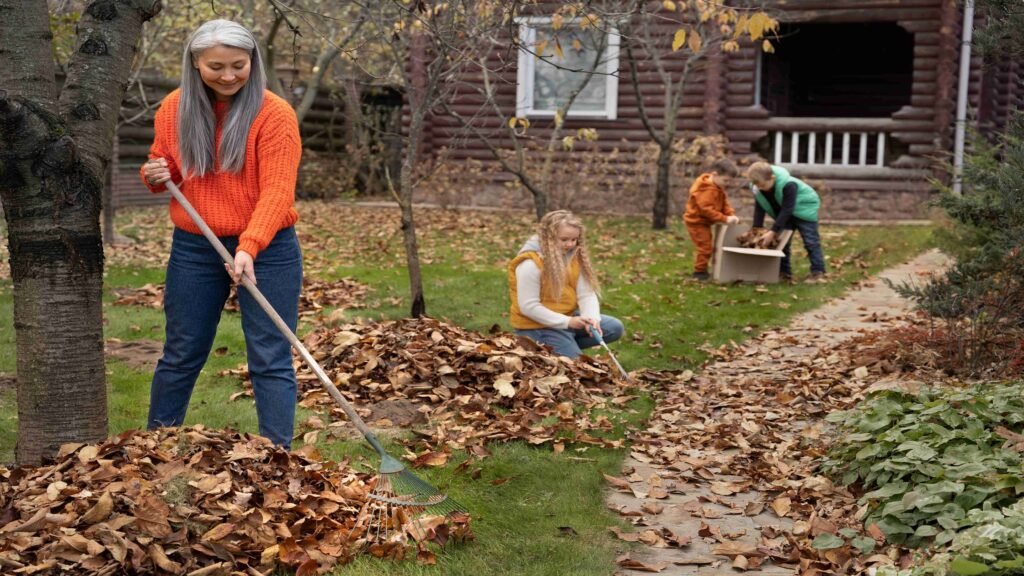Remove yard waste can seem overwhelming, but it doesn’t have to be. Start by collecting all debris like leaves, branches, and grass clippings. Composting is a great option, turning organic waste into nutrient-rich soil. Alternatively, many cities offer yard waste removal services that can pick up your waste curbside.
You can also haul the waste to a local disposal site. Properly managing yard waste not only keeps your property tidy but also helps the environment. Choose the method that best suits your needs and contribute to a cleaner, greener community.
Types Of Yard Waste
Remove yard waste can be a daunting task, but it doesn’t have to be. Understanding the types of yard waste is crucial. Yard waste generally falls into two categories: organic and non-organic materials. Knowing the difference helps in proper disposal and recycling. This guide will help you identify and manage various types of yard waste efficiently.
Organic Materials
Organic materials are natural and can decompose over time. These materials are ideal for composting. Composting turns yard waste into valuable fertilizer for your garden.
Common organic materials include:
- Grass clippings – These can be left on the lawn to decompose.
- Leaves – Rake them up and add to a compost pile.
- Branches and twigs – These can be chipped into mulch.
- Weeds – Remove weeds before they seed to prevent spreading.
- Garden trimmings – This includes flowers and vegetable plants.
Proper disposal of organic materials is essential. It helps in reducing landfill waste.
Here is a quick guide on how to manage these materials:
| Material | Disposal Method |
| Grass Clippings | Leave on lawn or compost |
| Leaves | Compost or mulch |
| Branches | Chop and use as mulch |
| Weeds | Dispose in green waste bin |
| Garden Trimmings | Compost or green waste bin |
Non-organic Materials
Non-organic materials do not decompose naturally. These materials require special disposal methods.
Common non-organic materials include:
- Plastic pots – These should be recycled if possible.
- Garden tools – Donate or recycle old tools.
- Hoses – Check if they can be recycled or repurposed.
- Fencing materials – These include wood, metal, and plastic.
- Decorative items – Garden statues or ornaments often need special disposal.
Proper disposal of non-organic materials is vital. It helps in reducing environmental pollution.
Here are some tips on how to manage these materials:
| Material | Disposal Method |
| Plastic Pots | Recycle or reuse |
| Garden Tools | Donate or recycle |
| Hoses | Recycle or repurpose |
| Fencing Materials | Contact local waste management |
| Decorative Items | Special disposal or recycling |
Tools For Yard Waste Removal
Yard waste can make your garden look messy. Remove yard waste keeps your garden clean and healthy. Various tools can help you get rid of yard waste. Some tools use your hands, while others need power. Let’s explore these tools to make your yard tidy.
Hand Tools
Hand tools are simple and easy to use. They do not need electricity or fuel. These tools are great for small tasks in the yard.
Here are some common hand tools for yard waste removal:
- Rakes: Rakes help gather leaves and grass clippings. They come in different sizes and shapes.
- Pruners: Pruners cut small branches and shrubs. They are perfect for trimming plants.
- Shovels: Shovels move soil, mulch, and other materials. They are useful for digging and lifting.
- Hand Saws: Hand saws cut through thicker branches. They are handy for pruning trees.
Hand tools are light and easy to carry. They are also safer for kids to use with adult supervision. Always keep your tools clean and sharp. This helps them last longer and work better.
Power Tools
Power tools make yard work faster and easier. They use electricity, batteries, or fuel. These tools are good for bigger tasks. Here are some common power tools for remove yard waste:
- Lawn Mowers: Lawn mowers cut grass quickly. They come in different sizes and types, like electric or gas.
- Leaf Blowers: Leaf blowers move leaves into piles. They can be handheld or backpack models.
- Chainsaws: Chainsaws cut large branches and trees. They are powerful and need careful handling.
- Hedge Trimmers: Hedge trimmers shape bushes and hedges. They can be electric, battery, or gas-powered.
Power tools save time and effort. They are great for large yards and heavy tasks. Always follow safety instructions when using power tools. Wear protective gear like gloves and goggles.
Best Practices For Collection
Yard waste can accumulate quickly, creating an unsightly and potentially hazardous environment. Proper remove yard waste is essential for maintaining a clean, safe, and healthy outdoor space. Best practices for collection ensure that yard waste is disposed of efficiently and responsibly. Following these practices helps keep your yard looking neat while also benefiting the environment.
Sorting Waste
Sorting yard waste is crucial for effective removal. It ensures that different types of waste are disposed of correctly.
Start by identifying the different types of yard waste:
- Grass clippings: These can be left on the lawn to decompose naturally.
- Leaves: Collect them in bags or compost them.
- Branches and twigs: Cut them into smaller pieces for easier disposal.
- Weeds: Bag them to prevent spreading.
Each type of yard waste requires a different disposal method. This helps in recycling and composting efforts. For example, grass clippings can be used as mulch. Leaves are great for composting. Branches and twigs can be chipped for mulch or burned, if local regulations allow.
Proper sorting also reduces the amount of waste sent to landfills. This benefits the environment and helps in resource conservation. Always check with your local waste management services for specific guidelines. They often provide information on how to sort and dispose of yard waste properly.
Using Containers
Using the right containers for yard waste collection is important. It helps in efficient and safe disposal.
Here are some tips for choosing the right containers:
- Biodegradable bags: These are great for leaves and grass clippings. They decompose along with the waste.
- Reusable bins: Use these for heavier items like branches and twigs. They are sturdy and can be used multiple times.
- Paper bags: These are suitable for lighter yard waste. They are also eco-friendly.
Label your containers clearly. This helps in identifying the type of waste inside. It makes collection easier for waste management services. Always keep the containers in a dry place. This prevents moisture from causing odors and attracting pests.
Using appropriate containers also helps in complying with local regulations. Many communities have specific guidelines for yard waste disposal. Following these ensures that your yard waste is collected promptly and efficiently.
Disposal Methods
Remove yard waste is essential for maintaining a clean and healthy environment. Different disposal methods can help you handle yard waste effectively. Here we explore two main methods: composting and landfill options.
Composting
Composting is a great way to recycle yard waste. It turns organic material into nutrient-rich soil. This method not only helps the environment but also benefits your garden.
Here are some steps to start composting:
- Gather yard waste like leaves, grass clippings, and small branches.
- Find a good spot in your yard for the compost pile or bin.
- Layer the yard waste with kitchen scraps and other organic materials.
- Keep the compost moist and turn it regularly for aeration.
Benefits of composting:
- Reduces the amount of waste sent to landfills.
- Produces natural fertilizer for gardens.
- Helps retain soil moisture and reduces the need for watering.
- Improves soil structure and health.
Important tips:
- Avoid adding meat, bones, and dairy products to your compost.
- Balance greens (nitrogen-rich) and browns (carbon-rich) materials.
- Use a compost thermometer to monitor the temperature.
- Be patient; composting takes time.
Landfill Options
Sometimes, yard waste cannot be composted. In such cases, landfill options are available. Many communities offer yard waste collection services.
Here are some ways to make use of landfill options:
- Check with your local waste management service for yard waste pickup schedules.
- Separate yard waste from regular household trash.
- Use biodegradable bags if required by your waste collection service.
- Ensure branches and large items are cut to the required size.
Considerations for landfill options:
- Landfilling yard waste should be a last resort.
- Landfills can contribute to greenhouse gas emissions.
- Some areas have specific regulations for yard waste disposal.
Alternatives to landfilling:
- Look for local recycling centers that accept yard waste.
- Consider hiring a professional yard waste removal service.
- Check if local farms or community gardens need compost materials.
Local Regulations
Yard waste can pile up quickly. It’s important to know how to remove it properly. Many places have local regulations. This guide will help you understand these rules. You’ll learn about collection schedules and permits required.
Collection Schedules
Different areas have different yard waste collection schedules. It’s important to know your area’s schedule. This helps you plan when to put out your yard waste. Check your local government’s website. They usually have a schedule posted.
Here are some common types of yard waste and their collection schedules:
- Leaves and grass clippings: Often collected every week.
- Branches and twigs: Usually collected every other week.
- Large tree limbs: Sometimes collected once a month.
Make sure to follow the rules for yard waste bins. Some places require special bags. Others provide bins. Always check the guidelines. This will ensure your yard waste is picked up on time. If you miss your collection day, you may have to wait until the next one.
Permits Required
Some areas require permits for yard waste removal. This is especially true for large amounts. Check with your local government. They can tell you if a permit is needed. Getting a permit is usually easy.
Here are some steps to get a yard waste permit:
- Visit your local government office or website.
- Fill out the necessary forms. These usually ask for your address and type of waste.
- Pay any required fees. Some permits are free, while others may cost a small fee.
Having a permit ensures you follow local regulations. This helps keep your community clean and safe. Always check if you need a permit before starting a big yard project.
Frequently Asked Questions
What Is Yard Waste?
Yard waste includes grass clippings, leaves, branches, and other organic debris from your garden or lawn.
How Do I Dispose Of Yard Waste?
You can compost it, use a yard waste service, or take it to a local recycling center.
Can Yard Waste Be Recycled?
Yes, yard waste is recyclable. Composting or mulching are effective recycling methods.
What Tools Are Needed For Yard Waste Removal?
Common tools include rakes, leaf blowers, lawn bags, and pruning shears.
Can I Burn Yard Waste?
Burning yard waste is often illegal and harmful. Check local regulations before considering this option.
Conclusion
Efficient yard waste removal keeps your outdoor space clean and beautiful. Use proper tools and recycling methods for best results. Remember to follow local guidelines for disposal. Maintaining your yard regularly prevents waste buildup. A tidy yard enhances your home’s curb appeal and promotes a healthier environment.
Happy gardening!







